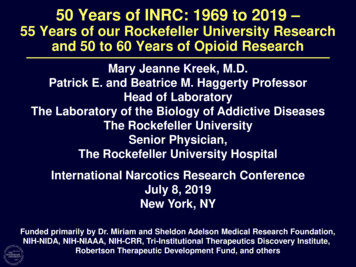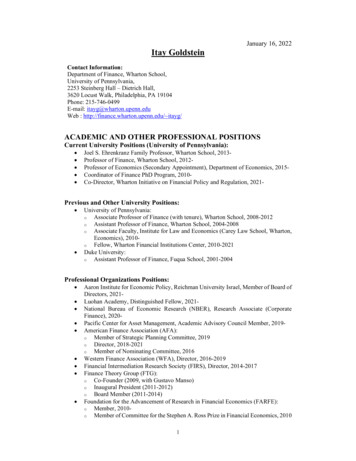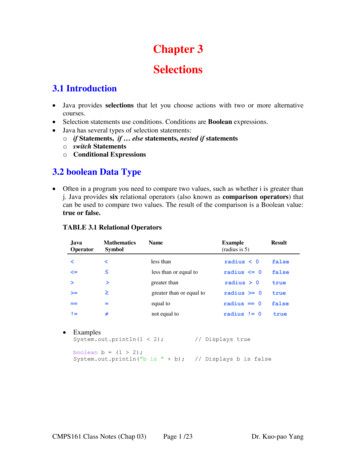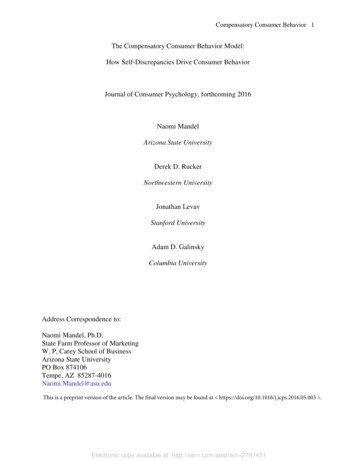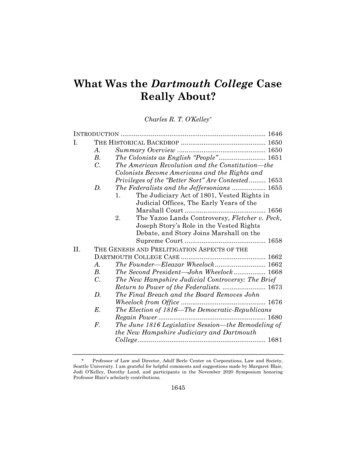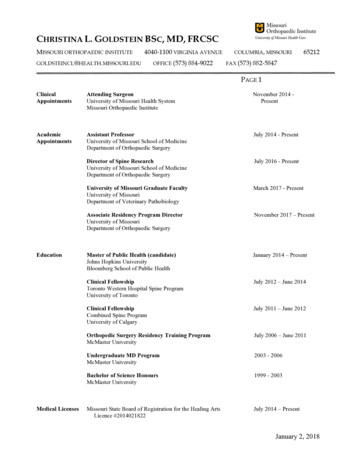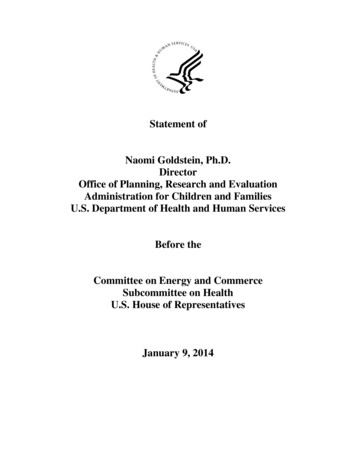
Transcription
Statement ofNaomi Goldstein, Ph.D.DirectorOffice of Planning, Research and EvaluationAdministration for Children and FamiliesU.S. Department of Health and Human ServicesBefore theCommittee on Energy and CommerceSubcommittee on HealthU.S. House of RepresentativesJanuary 9, 2014
Chairman Pitts, Ranking Member Pallone, and Members of the Subcommittee, thank you for theopportunity to testify today. My name is Naomi Goldstein, and I have served since 2004 asDirector of the Office of Planning, Research and Evaluation (OPRE) in the Administration forChildren and Families (ACF), Department of Health and Human Services (HHS).ACF promotes the economic and social well-being of families, children, individuals andcommunities through a broad array of programs carried out in partnership with states, territoriesand tribes, with other federal agencies, and with community-based organizations and localgovernments. I am pleased to share with you today information about the activities of a few ofthese programs, and what we are learning from them.ACF’s Office of Planning, Research and Evaluation studies ACF programs and the populationsthey serve. OPRE conducts its work primarily through competitively awarded grants andcontracts for research and evaluation projects. We aim to make our work both rigorous andrelevant, and to disseminate it in ways that are useful for policy-makers and practitioners.ACF appreciates your interest in our work, and welcomes the opportunity to discuss with you theHealth Profession Opportunity Grants, Abstinence Education, and Personal ResponsibilityEducation Programs. I will also speak about ACF’s collaboration with the Health Resources andServices Administration (HRSA) on the evaluation of the Maternal, Infant and Early ChildhoodHome Visiting Program.Health Profession Opportunity Grant ProgramThe Health Profession Opportunity Grants (HPOG) Program funds training in high-demandhealthcare professions targeted to Temporary Assistance for Needy Families (TANF) recipientsand other low-income individuals. The program is designed to meet the demand for healthcareworkers in communities and improve the job prospects for adults from hard-working families,matching careers in a growing field with people who are eager to fill them.The program was established by the Affordable Care Act (ACA). In 2010, ACF awarded fiveyear funding to 32 grantees in 23 states. Five of the grantees are tribal organizations. ACFprovides approximately 67 million annually to these grantees. HPOG grantees are postsecondary educational institutions; workforce investment boards (WIBs), state and localgovernment agencies, and community-based organizations. Grantees coordinate services withstate and local WIBs, state and local TANF agencies and federal and state offices ofApprenticeship, among other partners.Career pathways (CP) programs have developed over the past decade as a comprehensiveframework of adult developmental and vocational education and supportive services designed toaddress the challenge of providing post-secondary skills training to low-income andeducationally disadvantaged populations. This framework builds on past research showing thatsimilar programs can improve employment and earnings.1,2,3,4,51Bragg, D., Harmon, T., Kirby, C., & Kim, S. (2010, August). Bridge programs in Illinois: Summaries, outcomes, and cross-sitefindings. Champaign, IL: Office of Community College Research and Leadership, University of Illinois.
As of December 2013, approximately 25,800 participants have enrolled in HPOG programs. Ofthe more than 12,000 participants who have completed an occupational or vocational trainingprogram, more than 10,000 participants have become employed since the program began.Among those who became employed, their average wage is 12.37 per hour.The majority of HPOG participants were single females at program entry, with one or moredependent children. While most were not TANF recipients at enrollment, most had a householdincome of less than 20,000 when starting the program, and almost two-thirds received someform of public assistance at program intake. The most common training among participants ispreparation to become a nursing assistant, aide, orderly, or patient care attendant, generally shorttraining courses that can be the first step in a longer career pathway. Other common trainingsincluded instruction to be a licensed or vocational nurse, registered nurse, and medical assistant.HPOG participants also engaged in pre-training college study skills and basic skills educationclasses. Grantees provide a variety of support services including case management andcounseling services; financial assistance for tuition, books, and fees; and social service supports,including assistance with transportation, child care and emergency assistance. Grantees alsoprovide employment assistance in the form of job search workshops, career coaches, andplacement and retention assistance.ACF is using a multi-pronged research and evaluation strategy to examine outcomes and impactsfor HPOG participants as well as program implementation and systems change resulting fromHPOG programs. The HPOG impact evaluation uses a rigorous random assignment design thatwill show how variations in program services affect program impacts. The HPOG impactevaluation report, to be released in 2016, will report on education impacts such as credentialattainment and impacts on employment and earnings as well as job quality for participants15 months after program entry.All HPOG grantees are participating in a companion study on program implementation, systemschange, and outcomes. ACF will complete and release interim reports from this study in 2014and a final report in 2017, as well as interim and final tribal program evaluation reports in 2014and 2015.While the formal evaluations are still in progress, we have already heard first-hand aboutgrantees that are addressing barriers to employment through innovative strategies andpartnerships. For example, Bergen Community College is the lead organization for a consortiumthat includes ten community colleges in Northern New Jersey and has designed a “boot camp”2Helmer, M., & Blair, A. (2011, February). Courses to employment: Initial education and employment outcomes findings forstudents enrolled in Carreras en Salud Healthcare Career Training 2005–2009. Washington, DC: The Aspen Institute. Retrievedfrom arnett, E., Bork, R., Mayer, A., Pretlow, J., Wathington, H., & Weiss, M. (2012). Bridging the gap: An impact study of eightdevelopmental summer bridge programs in Texas. New York, NY: National Center for Postsecondary Research.4Maguire, S., Freely, J., Clymer, C., Conway, M., & Schwartz, D. (2010). Tuning in to local labor markets: Findings from theSectoral Employment Impact Study. Philadelphia: Public/Private Ventures.5Roder, A., & Elliot, M. (2011, April). A promising start: Year Up’s initial impacts on low-income young adults’ careers. NewYork: Economic Mobility Corporation.
curriculum that provides participants with an orientation to healthcare occupations. As anotherexample, Central Susquehanna Intermediate Unit in Pennsylvania is using “Google hangouts” tofacilitate real-time tutoring and homework assistance in a highly rural ten-county service area tosupport students who are completing healthcare training programs. In California, the San DiegoWorkforce Partnership initiated the formation of a “common customer workgroup” that bringstogether workforce and human services agencies to streamline their efforts while also helpingparticipants navigate the system more easily.Personal Responsibility Education ProgramTeen birth rates have fallen significantly in recent years. Nevertheless, births to teens remainrelatively common in the U.S. Preliminary data for 2012 indicate that more than 300,000children were born to mothers between the ages of 15 and 19. Teen births are associated with arange of negative outcomes for teen parents and their children. For example, teen parents usepublic assistance more often and finish high school less often. Furthermore, it is estimated thatteen childbearing in the U.S. costs taxpayers billions a year in lost revenue and increasedexpenditures for foster care, public assistance, and criminal justice services.Congress authorized a new evidence-based teen pregnancy prevention program called thePersonal Responsibility Education Program (PREP) through the ACA. The program is designedto educate adolescents on “both abstinence and contraception for the prevention of pregnancyand sexually transmitted infections” and to prepare youth for adulthood by addressing topicssuch as healthy relationships, adolescent development, and healthy life skills. It is funded at 75million a year through fiscal year 14 and is administered by the Family and Youth ServicesBureau (FYSB), within ACF.The program design was guided by research and evaluation that has demonstrated what works toreduce teen pregnancy. In 2010, HHS sponsored a transparent, systematic review of the teenpregnancy prevention evidence base, in order to independently identify teen pregnancyprevention programs with evidence of impacts on teen pregnancies or births, sexually transmittedinfections, or associated sexual risk behaviors. The review identified, assessed, and rated therigor of program impact studies and described the strength of evidence supporting differentprogram models. The review is ongoing and partially supported by PREP funds. Based on thereview, HHS identified evidence-based programs, defined as those with: (1) studies with designsthat have the best chance of finding unbiased impact estimates; and (2) a positive, statisticallysignificant impact on sexual activity, contraceptive use, sexually transmitted infections,pregnancies, or births. There are now 31 different program models that have met the reviewcriteria for evidence of program effectiveness. Most youth served through PREP formulafunding (93 percent) will participate in one of these evidence-based programs. We released areport last fall on how states are scaling up these evidence-based programs; the report alsohighlights how some states are reaching their target populations.Let me highlight three key accomplishments of the PREP program to date. First, the reach of theprogram is quite broad. States plan to serve a total of 300,000 youth through formula grantfunding over the course of the five-year grant period. These youth are being reached through
over 300 different program providers operating in over 1,300 different sites across the country.Second, most state grantees are focusing on high-risk youth. Three-fourths of state programproviders operate in high-need geographic areas. And third, state PREP grantees are creating aninfrastructure to support successful replications of evidence-based programs through training,technical assistance, and monitoring.The PREP program includes two key components – formula grants for evidence-based programsand competitive grants for promising programs. The majority of the funding ( 55 million a year)is available via formula grants for states and territories. Programs funded through these grantsare required either to be evidence-based or to substantially incorporate elements of evidencebased programs. Forty-nine states and territories draw down formula grant funding. In the statesand territories that have not taken up formula grant funding, unallocated funds are awarded toorganizations within the state or territory via competitive grants. Within these states andterritories, a total of 37 grantees receive competitive funding. In addition, 10 million was madeavailable through PREP for competitive grants to implement and evaluate promising new teenpregnancy prevention strategies. Twelve grantees receive funding through these competitivegrants for innovative strategies. Finally, about 3 million a year is available for competitivegrants to tribes and tribal organizations.We now have the opportunity to add to our knowledge about what works to reduce teenpregnancy – and to learn more about what it means to scale up evidence-based programs–through an independent evaluation that ACF is sponsoring of the PREP program. MathematicaPolicy Research, our evaluation contractor, is: (1) conducting a descriptive study to documenthow PREP programs are designed and are implemented by states; (2) collecting and analyzingperformance measure data for all formula-grant funded PREP programs; and (3) assessing theeffectiveness of four specific PREP-funded programs, with an eye to filling gaps in the teenpregnancy prevention evidence base. In 2013, we released a report from the descriptive study(which I discussed earlier). The report documents key decisions states made about the design oftheir PREP programs. Further findings from the evaluation will be released on a rolling basis,culminating in short-term and long-term impact findings from the four selected sites in 2016 and2018, respectively.Abstinence EducationThrough the Title V State Abstinence Education Program, 50 million per year is available viaformula grants to states “to enable the State to provide abstinence education, and at the option ofthe State, where appropriate, mentoring, counseling, and adult supervision to promote abstinencefrom sexual activity.” The program was first authorized in 1996 by the Personal Responsibilityand Work Opportunity Reconciliation Act, and was most recently authorized by ACA. In FY13,39 states and territories drew down Title V funding. The program also is administered byFYSB’s Adolescent Pregnancy Prevention Program.The program provides funds to states to teach young people the social, psychological and healthgains to be realized by abstaining from sexual activity. States are encouraged to developflexible, effective abstinence-based plans that are responsive to their specific needs. As part of
those plans, states are encouraged to use abstinence education models that are evidence-basedand all models must provide medically accurate information.Many states focus directly on youth in foster care, and one state, Kansas, has dedicated the entireprogram to abstinence education for youth in foster care and the parents, adoptive parents,agency staff, and community professionals impacting the lives of children in foster care. Mostgrantees also include mentoring, counseling or adult supervision in some capacity.In the 1990s and 2000s, HHS funded an evaluation of four programs, which showed that youth inthe program group were no more likely than control group youth to have abstained from sex; atthe same time, program group youth were no more likely to have engaged in unprotected sexthan control group youth.More recently, HHS has reviewed the current evidence base for teen pregnancy preventionprogramming and found three abstinence program models to meet the criteria for evidence ofeffectiveness. These models are: Promoting Health Among Teens – Abstinence Only;Making a Difference; andHeritage Keepers Abstinence Education.The Abstinence Education statute provides no authority for dedicated research and evaluationfunding. However, HHS is supporting evaluation of abstinence education through some of itsbroad teen pregnancy prevention research and evaluation activities. For example, a PREPgrantee, Lighthouse Outreach in Virginia, is conducting an evaluation including an abstinencecurriculum and a character-development curriculum.Research and evaluation in the Maternal, Infant and Early Childhood Home VisitingProgram (MIECHV)As Dr. Lu mentioned, HRSA and ACF collaborate on implementing the MIECHV program. Dr.Lu mentioned our collaboration on research and evaluation for this program, and I will providesome additional detail. The MIECHV program is based on a large body of research on theeffectiveness of home visiting for pregnant women and families with young children. Impactshave been seen across a broad range of outcomes, including maternal health, school readiness,parenting, prevention of child maltreatment, and family economic self-sufficiency. TheMIECHV statute calls for a rich set of research and evaluation activities to continue to generatenew knowledge. First, it requires the Secretary of HHS, to establish criteria for evidence ofeffectiveness and to reserve the majority of program funding for home visiting models that meetthose criteria. Second, the statue requires a national evaluation of MIECHV. Third, it calls forrigorous evaluation of promising approaches implemented by grantees, that is, home visitingmodels that don’t meet the evidence criteria. Fourth, it calls for the collection of performancemanagement data by grantees. Finally, it calls for an ongoing portfolio of research andevaluation activities.
Following an opportunity for public comment, in 2010 the Secretary established criteria forevidence of effectiveness of home visiting models. ACF awarded a contract to conduct athorough, transparent, systematic review of the evidence on models of home visiting, applyingthese criteria. This project is known as the Home Visiting Evidence of Effectiveness, orHomVEE. It conducts an exhaustive literature search for impact studies, determines the qualityof the studies based on their ability to produce unbiased impact estimates, and assesses whetherthe available evidence for particular home visiting models meets the HHS criteria. The projectconducts annual reviews to update the evidence on models that have already been reviewed andto review emerging evidence on models not yet reviewed. To date, the project has reviewed 35models and found 14 to have evidence of effectiveness.The statute directs HHS to conduct a national evaluation of MIECHV and includes specificrequirements related to the evaluation. First, it requires the establishment of an AdvisoryCommittee which has reviewed the design of the study and outline of the Report to Congress,which is due in March, 2015. Second, the law requires that the evaluation examine the states’needs assessments, address all the outcome domains noted in the legislation, examine impactsacross different models and populations, and include a cost study. The evaluation, known as theMother and Infant Home Visiting Program Evaluation (MIHOPE), uses a rigorous randomassignment design to answer questions of overall impacts as well as impacts for individual homevisiting models. It will examine features of models and their implementation that lead tostronger impacts, and will include information on the costs of implementing home visitingmodels and the cost effectiveness of MIECHV.In order to support grantees in evaluating promising approaches and collecting benchmarkperformance management data, we have provided technical assistance to grantees on establishingbenchmarks, creating data systems, reporting performance management data, buildingcontinuous quality improvement processes and conducting rigorous evaluations.Finally, the legislation calls for an ongoing portfolio of research and evaluation. ACF andHRSA have undertaken activities including a tribal research center, investigator-initiated grants,and a home visiting research network to build on the prior work and expand the knowledge base.Thank you again for inviting me to testify. I would be happy to address any questions.
relatively common in the U.S. Preliminary data for 2012 indicate that more than 300,000 children were born to mothers between the ages of 15 and 19. Teen births are associated with a range of negative outcomes for teen parents and their children. For example, teen parents use public assistance more often and finish high school less often.
